
About UsThe Numismatic Bibliomania Society is a non-profit organization promoting numismatic literature. For more information please see our web site at coinbooks.org SubscriptionsThose wishing to become new E-Sylum subscribers (or wishing to Unsubscribe) can go to the following web page link MembershipThere is a membership application available on the web site Membership Application To join, print the application and return it with your check to the address printed on the application. Membership is only $15 to addresses in the U.S., $20 for First Class mail, and $25 elsewhere. For those without web access, write to: David M. Sundman, Secretary/TreasurerNumismatic Bibliomania
Society AsylumFor Asylum mailing address changes and other membership questions, contact David at this email address: dsundman@LittletonCoin.com SubmissionsTo submit items for publication in The E-Sylum, just Reply to this message, or write to the Editor at this address: whomren@coinlibrary.com
BUY THE BOOK BEFORE THE COINYou won't regret it! |
- WAYNE'S WORDS: THE E-SYLUM JANUARY 25, 2009
- CHARLES DAVIS NUMISMATIC LITERATURE MAIL BID SALE CLOSES JANUARY 31, 2009
- LAKE BOOKS 96TH MAIL BID SALE PRICES REALIZED AVAILABLE
- DOUGLAS SAVILLE ON THE JANUARY 10TH 2009 KOLBE LITERATURE SALES
- NEW BOOK: THE WHITMAN ENCYCLOPEDIA OF COLONIAL AND EARLY AMERICAN COINS
- NEW BOOK: COLLECTING GUIDE TO THE PIONEER MINOR COINAGE OF AMERICAN SALOONS
- NEW BOOK: COFFEE TOKENS OF COSTA RICA
- NEW BOOK: GOLD COINS OF THE CHARLOTTE MINT THIRD EDITION BY DOUGLAS WINTER
- ANNOUNCEMENT: MEDAL COLLECTORS OF AMERICA'S ORAL HISTORY OF MEDALLIC ART
- MICHAEL MAROTTA ON BURDETTE'S GUIDE BOOK OF PEACE DOLLARS
- CORRECTION: OFFICIAL OBAMA INAUGURAL MEDAL OBVERSE IS BY MARK MELLON
- QUERY: IMAGE OF ARMAND-DELILLE RABBIT MEDAL SOUGHT
- QUERY: NUMISMATIC AND EXONUMIC INAUGURAL SOUVENIRS SOUGHT FOR WHITMAN VAULT BOOK PROJECT
- HAS EARLY ARTWORK FOR THE MORGAN DOLLAR BEEN FOUND?
- MORE ON DANIEL CARR'S HARD TIMES TOKENS
- MORE ON "ABRAHAM LINCOLN TURNS 200"
- ON THE SOCIETY OF BEARDED NUMISMATISTS
- ON MEDALS AND THE ORIGINS OF TRADEMARKS
- ON THE ANA'S LAMP OF KNOWLEDGE LOGO
- MIKE ELLIS ANNOUNCES RUN FOR ANA BOARD
- MORE ON THE FIRST APPEARANCES OF THE SESTERTIUS AS A COIN
- ON EVALUATING THE VALUE OF MONEY OVER TIME
- WILL EUROPEAN NATIONS CONSIDER DROPPING CENT COINS?
- WHO'S HELPING ZIMBABWE PRINT ITS HYPERINFLATIONARY BANKNOTES?
- MONEY AND HOW IT GOT THAT WAY: A LOOK AT MONEY AND ART
- ROYAL MINT MISTAKE: 2008 OLD STYLE OBVERSE MULED WITH NEW STYLE REVERSE
- STOLEN SILVER PENNY OF EDWARD THE CONFESSOR RETURNED TO ABBEY
- FEATURED WEB PAGE: MEDALLIC HISTORY OF INTOLERANCE
WAYNE'S WORDS: THE E-SYLUM JANUARY 25, 2009
 Among our recent subscribers is J. Bussman. Welcome aboard! We now have 1,227 subscribers.
Among our recent subscribers is J. Bussman. Welcome aboard! We now have 1,227 subscribers. This week we open with a reminder about Charlie Davis's upcoming numismatic literature sale, and notes on recent sales by Fred Lake and George Kolbe.
Next, we have several announcements and reviews of new numismatic books, and items on topics including inaugural medals and souvenirs, the Society of Bearded Numismatists and the ANA. One important announcement for researches is the Oral History of Medallic Art project sponsored by MCA.
To help clear up some possible confusion, please note that the SSNYFREE code mentioned last week is for free SHIPPING of the S.S. New York book, not a free book. Sorry!
To learn about the dead rabbit medal, read on. Have a great week, everyone!
Wayne Homren
Numismatic Bibliomania Society
CHARLES DAVIS NUMISMATIC LITERATURE MAIL BID SALE CLOSES JANUARY 31, 2009
Charlie Davis would like to remind readers that his current mail bid sale of "Numismatic Literature Surplus from the Library of the American Numismatic Society and Other Consignors" closes January 31st. Highlights include:- American Journal of Numismatics Volumes 1-25
- Superb deluxe Beistle Early Half Dollars
- Early Q. David Bowers Publications
- Crosby Early Coins of America
- Superb 1925 Browning Early Quarter Dollars
- Elder Magazine complete
- Superb set of Frossard’s Numisma
- Husak Large Cent Catalogue; 3/100 deluxe edition
- Mehl’s Monthly bound in by Alan Grace
- First Notice (1950) of the “D” punched on 1804 $
- Fine original Newlin on Half Dimes
- Raymond 1935 Standard Catalogue leatherbound
- Early American Cents - signed
- Scott Coin Collector’s Journal complete
- Long run of Red Books, signed and special editions
- World’s Greatest Collection, Dr. Judd’s full calf ed
- Demetrio Numismatique Egypte Ancienne
- Mionnet complete in 16 volumes
- Complete bound SNG Copenhagen
- Blades List of Medals 1869
- Blades Numismatica Typographica
- Burns Coinage of Scotland, large paper
- Lavoix Monnaies Musilmanes, 3 volumes
For more information on the sale, see our earlier E-Sylum article: CHARLES DAVIS JANUARY 31, 2009 NUMISMATIC LITERATURE MAIL BID SALE (www.coinbooks.org/esylum_v12n01a03.html)
LAKE BOOKS 96TH MAIL BID SALE PRICES REALIZED AVAILABLE
DOUGLAS SAVILLE ON THE JANUARY 10TH 2009 KOLBE LITERATURE SALES
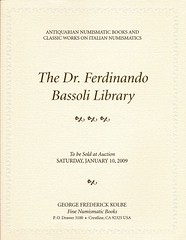 The Bassoli library was formed over many years, by a knowledgeable Italian collector. George Kolbe was commissioned to sell the library at auction and the sale was held at the NYINC on January 10.
The Bassoli library was formed over many years, by a knowledgeable Italian collector. George Kolbe was commissioned to sell the library at auction and the sale was held at the NYINC on January 10.I travelled to New York from London on January 8, and viewed the books on Friday. The lots were neatly arranged on tables in the rather aptly-named Carnegie Suite of the Waldorf Astoria Hotel. More than 95% of the lots had been shipped from California. Considering the viewing was located just yards from the main Bourse areas, I was surprised, perhaps even relieved, that relatively few dealers and collectors turned up to view the books.
 The US library - the “Twinleaf” sale - was considerably less interesting to me, having always been “confused” by US numismatic literature. Having said that, I was the disappointed under-bidder on the outstanding Jonathan Swift “Defence of the People of Ireland” a rare work on Wood’s coinage (Lot 94), that realized $12,000 on a $5000 estimate. I really felt it should have returned to the UK…….. The Twinleaf library seemed to sell reasonably well, with few lots remaining unsold. It did not auger well for my chances of buying many lots in the Bassoli library, to be sold shortly after.
The US library - the “Twinleaf” sale - was considerably less interesting to me, having always been “confused” by US numismatic literature. Having said that, I was the disappointed under-bidder on the outstanding Jonathan Swift “Defence of the People of Ireland” a rare work on Wood’s coinage (Lot 94), that realized $12,000 on a $5000 estimate. I really felt it should have returned to the UK…….. The Twinleaf library seemed to sell reasonably well, with few lots remaining unsold. It did not auger well for my chances of buying many lots in the Bassoli library, to be sold shortly after.After a short interval, the Bassoli library sale started with lot 101. I would say there were some 30 people in the room, with perhaps a further 7 or 8 telephone bidders- some no doubt from Europe.
In general, prices hovered around estimate, with, perhaps 15% of the lots remaining unsold. I suspect the owner may have insisted on too-high reserves on some of those lots.
Unquestionably, the outstanding lot of the sale, the Du Choul (Lot 150) in a superb contemporary full morocco gilt binding, sold for $12,000 on an estimate of 10,000, whilst Lot 193 a very fine and un-mutilated Le Pois, also in a contemporary (Eve) disappointed at $6750, a bargain, I would say, and with a less-than-excessive estimate of $7500.
Overall, there appeared to be no real surprises. However, lot 114, Barbarigo’s beautifully printed, and rather rare work, appeared a bargain at $3750, whilst Duby’s foundation work on Obsidional coins, even with Louis XVI’s Arms, would seem less of a bargain at $4000 on an estimate of $1750. Lot 162, a really charming, and rare, Fulvio, did poorly, I thought, at $4000, and the estimate appeared to be more than reasonable at $4500. The diminutive volume had been acquired from a Drury catalogue in 1983, where it had been listed for sale at £1000, yes, pounds! And I remember having tried to buy it at the time, only to be told it had already been sold “to Italy”.
A really beautiful two-volume set of Gaetani’s magnificent Museum Mazzuchellianum, the catalogue of a magnificent collection of medals, in a contemporary pasteboard binding, sold surprisingly slightly under estimate at $3000.
I would suspect many of these books “went home”, as it were, to Europe, some to Italy, but many, I know, will stay in the US, and a few, I am pleased to say, will go back to the UK, via me.
No doubt, the current economic conditions worldwide affected the prices realized for these beautiful books, the relatively low attendance by floor bidders at the sale of such a major library must have been disappointing for the owner, and the auctioneer. I have no doubt also that had the sale been held a year earlier, the owner might have been somewhat more satisfied. I am sure many collectors will look back at this sale and regret they were not more aggressive in their bids, and I am sure that I will not be an exception.
NEW BOOK: THE WHITMAN ENCYCLOPEDIA OF COLONIAL AND EARLY AMERICAN COINS

George Fuld, numismatic author and researcher:
The coins and tokens of colonial America and the early United States present a unique chronicle of the birth of the United States. They bear witness to Paul Revere, George Washington, and Benjamin Franklin. . . to distant European tyrants bent on empire, and cash-strapped merchants trying to make a living. If these historic coins could speak, they would tell of generations of hardworking, independent, and innovative Americans, both famous and obscure.
Collectors of these fascinating coins have never had a single, authoritative reference for guidance—until now. Q. David Bowers, the “Dean of American Numismatics”—drawing on the expertise of dozens of specialists from around the country—has written a book so comprehensive and authoritative that it redefines the genre. The Whitman Encyclopedia of Colonial and Early American Coins explores:
- Collecting, grading, and attributing colonial coins
- Money in early America
- Minting and distribution
- Silver coins of Massachusetts
- Early British coins and tokens for America
- American coins and tokens from 1783 to 1788
- Other early American pieces
- Later European coins and tokens for America
- Early George Washington coins and tokens
- Related foreign coins
- 19th-century colonial copies and fantasies
Bowers’s engaging text is supported by nearly 2,000 full-color photographs, “Easy Find Guides” for identifying varieties, extensive auction data, market values and commentary, historical price trends, rarities, a selected bibliography, and a comprehensive index with more than 700 entries.
Here’s what the experts are saying:
“Dave Bowers’s encyclopedic knowledge and devotion to American colonial and Confederation coinage are now transferred into a published encyclopedia for everyone to enjoy—so he can continue to write on even more topics.” —Eric P. Newman, numismatic researcher and author
“The Whitman Encyclopedia is a wonderful, and much needed, platform for encouraging the historical research of our colonial time period.” —Ray Williams, president, Colonial Coin Collectors Club
“Finally, after 200 years, those interested in early American coins have an up-to-date book on all known die varieties. Q. David Bowers has once again given the numismatic world a great gift.” —Richard August, state and Fugio die-variety specialist
“The Whitman Encyclopedia of Colonial and Early American Coins is very easy to read, while presenting a great deal of useful information. I especially like the finding guides included for the major series. Bowers’s discussion of the Massachusetts coppers is one of the best I have read.” —Louis E. Jordan III, Head of Special Collections and Medieval Institute Library, University of Notre Dame
“A reference such as this has been needed for a long time. None of the standard references of the past are satisfactory. The Whitman Encyclopedia of Colonial and Early American Coins is a welcome addition to the libraries of colonial specialists as well as the more general collector of American coins—and I can’t think of anyone better qualified than Q. David Bowers to accomplish this effort.” —Sydney Martin, Connecticut copper specialist, editor, Colonial Coin Collectors Club Newsletter
“Dave Bowers has written the book that collectors of colonial and early American coinage have waited 150 years to read—covering expert information with authority, yet written with such marvelous clarity that even novice collectors will find it indispensable.” —Joel J. Orosz, numismatic researcher and author
“What an incredible, immensely useful, and important book Dave Bowers has put together!” —Roger Siboni, president, American Numismatic Society
NEW BOOK: COLLECTING GUIDE TO THE PIONEER MINOR COINAGE OF AMERICAN SALOONS
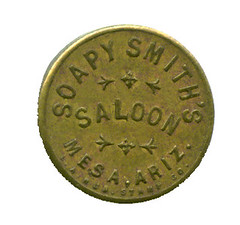 The idea for this collecting guide was born of the Holabird Americana pioneer minor coinage auctions that were so successful over the past two decades. Collectors constantly asked questions about rarity, availability and stories. The Collecting Guide is the result of these questions. It is intended to introduce saloon token collecting to all audiences, and make it fun in the process.
The idea for this collecting guide was born of the Holabird Americana pioneer minor coinage auctions that were so successful over the past two decades. Collectors constantly asked questions about rarity, availability and stories. The Collecting Guide is the result of these questions. It is intended to introduce saloon token collecting to all audiences, and make it fun in the process. The text in this guide is markedly different from other works. Our goal was fun stories from each state. Along the way we realized that different states had different alcohol laws that directly relate to token rarity. We spent the better part of two and a half years acquiring and researching these wonderful coins. This book is the compilation of a massive effort on the part of the entire Holabird-Kagin Americana staff.
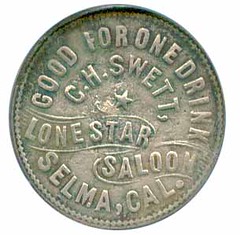 Saloons are as much a fixture of the American West as cowboys, Indians and six-shooters. Saloon tokens are some of the most sought-after tokens or coins by collectors today. They have existed for a millennia and once included many types of businesses such as coffee houses, restaurants, ice cream parlors, road houses, bars, taverns, billiard halls, and brothels.
Saloons are as much a fixture of the American West as cowboys, Indians and six-shooters. Saloon tokens are some of the most sought-after tokens or coins by collectors today. They have existed for a millennia and once included many types of businesses such as coffee houses, restaurants, ice cream parlors, road houses, bars, taverns, billiard halls, and brothels.This book primarily deals with the pioneer minor coinage associated with the pre-Prohibition saloon. Merchants used “tokens,” a form of money or pioneer minor coinage as both change and advertising. The majority of American saloon tokens got their start during the Civil War, primarily from coffee house-type saloons. In the west, the use of the saloon token took off in the 1870s and was in wide usage by the late 1890s.
From Roughing It! By Mark Twain:
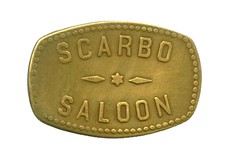 One popular category for saloon token collecting is the pre-1900 group, though these are harder to find (and verify). Many pre-1900 saloons advertised their saloons through the use of billiard manufacturers, who provided tokens with the merchant names on the obverse and the billiard manufacturer on the reverse, usually with a picture or vignette of a pool table. Most of the pool and billiard tables were manufactured in Chicago. Die sinkers there made tokens for many of the table manufacturers, and some of these are thought to have had an office in San Francisco to help facilitate the western saloon and pool table/billiard business.
One popular category for saloon token collecting is the pre-1900 group, though these are harder to find (and verify). Many pre-1900 saloons advertised their saloons through the use of billiard manufacturers, who provided tokens with the merchant names on the obverse and the billiard manufacturer on the reverse, usually with a picture or vignette of a pool table. Most of the pool and billiard tables were manufactured in Chicago. Die sinkers there made tokens for many of the table manufacturers, and some of these are thought to have had an office in San Francisco to help facilitate the western saloon and pool table/billiard business.NEW BOOK: COFFEE TOKENS OF COSTA RICA
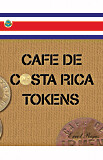 Web site visitor Errol Rojas writes:
Web site visitor Errol Rojas writes: The hobby has grown so much that Costa Rican tokens are now being sold and traded almost daily throughout the world. There are auction houses in the United States selling Costa Rican tokens and these tokens are even being sold on eBay. There is a coin show in San Jose , Costa Rica once a month where registered members display their items for sale; a large part of that includes tokens.
The first of three token books will be dedicated solely to Café de Costa Rica tokens and their varieties. The second book will be about a particular Costa Rican farm and the tokens used and their individual meanings. The third book will be what I call a master catalog. In that catalog I will list as many tokens from Costa Rica as possible.
I will include tokens from Amusement Parks, Casinos, Shooting ranges, Parking Meters, counters, foreign currency used as tokens, lead tokens, brass tokens, copper tokens, plastic tokens, bakelite tokens, aluminum tokens and alloy tokens. Included will be paper chits used as tokens. Costa Rica offers many exiting areas for token collectors to focus their attention.
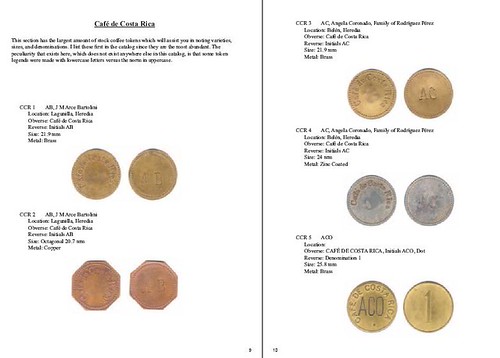
To visit Errol Rojas' Costa Rica tokens web site, see: www.costaricatokens.com
NEW BOOK: GOLD COINS OF THE CHARLOTTE MINT THIRD EDITION BY DOUGLAS WINTER
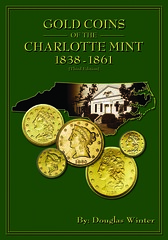 Douglas Winter’s Gold Coins of the Charlotte Mint is a one-of-a-kind numismatic reference that is devoted solely and exclusively to Charlotte Mint gold coins struck from 1838 to 1861. Winter, who is regarded today as one of the leading industry experts in U.S. branch mint gold coins, has completely updated his book, implementing significant changes, additions and corrections to reflect shifting conditions in the market and newly discovered information.
Douglas Winter’s Gold Coins of the Charlotte Mint is a one-of-a-kind numismatic reference that is devoted solely and exclusively to Charlotte Mint gold coins struck from 1838 to 1861. Winter, who is regarded today as one of the leading industry experts in U.S. branch mint gold coins, has completely updated his book, implementing significant changes, additions and corrections to reflect shifting conditions in the market and newly discovered information. High quality full color photos beautifully illustrate every coin and the newly improved die variety section now has outstanding close-up images of many important varieties. To bring the book up-to-date, similar layout designs to his previously released New Orleans and Dahlonega Mint books used in this current edition of the Charlotte Mint book make it easy to follow and more enjoyable to read.
All figures on population, rarity rankings, total values by grade and significant examples have been updated to reflect the latest market information available today, including a complete rarity summary chart at the end of each chapter.
For the historian, two chapters written about the history of the Charlotte Mint are included, and finally, Winter’s personal tips and strategies on how to collect C-mint gold coins guide the reader. Whether the collector is looking to buy one or two pieces or to complete a set, Winter’s suggestions offer an invaluable resource no matter what the budget or goal of the collector.
Jeff Ambio, author of the Strategy Guide series and a recognized numismatic expert, comments:
Order this book today from bookstores nationwide, Amazon.com or your local coin shop. Also available from Zyrus Press: PO Box 17810, Irvine, CA 92623. Phone: (888) 622-7823. Web: Stay up-to-date! Visit www.zyruspress.com. E-mail: info@zyruspress.com.
THE BOOK BAZARRE
ANNOUNCEMENT: MEDAL COLLECTORS OF AMERICA'S ORAL HISTORY OF MEDALLIC ART

The ORAL HISTORY feature will be set up in a similar way as that which links to MEMBERS' CORNER currently on the site. By clicking on the ORAL HISTORY link, the viewer will get a new page with introductory remarks, a list of the interviewers, the medallic historian being interviewed and brief descriptions of the content of the interviews. If the interview is very long, it would likely be broken up into sections so the download time is reasonable. The link to these oral histories will be available on every page of the website. As of this date, two oral histories have been posted. Many more are forthcoming.
The Oral History of Medallic Art project is the result of a close collaboration between the MCA webmaster Ben Weiss and several other members of the MCA, notably, John Adams, John Sallay, and Bob Fritsch. Special thanks go to Mark Schlepphorst, who did most of the initial work in setting up the technical aspects of the project and who has so generously offered to do the very large job of editing the interviews before they are posted, and to Dick Johnson, who not only provided several useful suggestions concerning the interviews but who also serves as one of the interviewers for this project.
This novel project will constitute an important new addition to our body of knowledge of the History of Medallic Art. The Internet is uniquely suited for this venture for it allows rapid and readily accessible dissemination of this information. By posting the interviews on our website it will place the MCA at the forefront of documenting the early history of the field of Medallic Art and making it readily available for all to hear and view.
The idea is to interview “old-timers” in order to capture the knowledge they’ve never had time to write down and record their recollections of the people and events that got us collectively where we are today. The concept is as old as written history itself, but taking oral histories has become a much more widely used tool with the advent of tape recorders, film, and videotape.
Since the MCA is a geographically dispersed organization, however, there were some challenges. First, we wrestled with how to get one or more enthusiastic members to meet with interesting subjects on a more than one-off basis. We’re rarely together and when we are, like at the ANA Convention or an auction, there are always other things going on. We also discussed how best to capture and share the interviews, since we didn’t want to have either one person responsible for a single recording device or have to deal with multiple recording formats. Finally, we talked about what to do with all of these recordings, since the MCA doesn’t have a central library.
Dick Johnson, who is an expert in taking oral histories, introduced me to Mark Schlepphorst, a relatively newer MCA member whose professional activity has overlapped with our various technical challenges. Mark initially suggested buying a device similar to what police departments use to record 911 calls. We could conduct the interviews over the phone, record them in a digital format rather than on tape, edit the recordings, and then post them on our MCA website. That way, anyone could listen to them on his or her computer or even download them onto an iPod or similar device. At this point, MCA webmaster Ben Weiss got more deeply involved in the project, and we discussed how exactly the process would work from beginning to end, both technically and practically.
At the recent MCA meeting held during the Baltimore ANA, we outlined the project and mentioned the concept of buying the phone-recording gizmo, perhaps sending it around by mail to members who wanted to conduct interviews. Bob Fritsch raised a key idea that he had raised previously on one of the board calls, only this time it registered. Why not use just a web-based conference calling service that offers recording capability? While there would be per-minute toll charges to the MCA, we would save all of the up-front cost and wouldn’t need to hassle with any physical machinery. Any member with a phone, computer and the necessary dial-in code could simply conduct an interview and arrange with Ben to post the recording on the MCA website.
Mark explored a number of conference calling services and found one that seems like it will best suit our needs. Mark Schlepphorst has agreed to coordinate the project from here, with Mark and Ben Weiss involved in editing and Ben in posting the interviews. Dick Johnson has volunteered to summarize his experience in conducting these sorts of interviews and outline a standard approach for all of us to follow. He has also volunteered to conduct the first few interviews, to show us how it’s done.
MICHAEL MAROTTA ON BURDETTE'S GUIDE BOOK OF PEACE DOLLARS
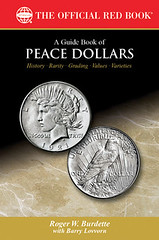 Allow me to offer another view of A Guide Book of Peace Dollars by Roger Burdette. Wayne Homren’s comments (E-Sylum Volume 12, Number 02, January 11, 2009) suggested that “the book's title should be A Guide Book of United States Peace Dollars.” Generally, “The Official Red Book” series from Whitman does not include a national term unless it truly differentiates the subject: The Official Red Book®—A Guide Book of United States Coins and A Guide Book of US Type Coins are two examples. Peace Dollars, Gold Dollars, Shield & Liberty Nickels, Lincoln Cents, and many others stand on their own. In support of that, I would like to know if there is any other coin ever made that is also known as a “Peace Dollar.” (I would accept a vredensdaalder if you have one.)
Allow me to offer another view of A Guide Book of Peace Dollars by Roger Burdette. Wayne Homren’s comments (E-Sylum Volume 12, Number 02, January 11, 2009) suggested that “the book's title should be A Guide Book of United States Peace Dollars.” Generally, “The Official Red Book” series from Whitman does not include a national term unless it truly differentiates the subject: The Official Red Book®—A Guide Book of United States Coins and A Guide Book of US Type Coins are two examples. Peace Dollars, Gold Dollars, Shield & Liberty Nickels, Lincoln Cents, and many others stand on their own. In support of that, I would like to know if there is any other coin ever made that is also known as a “Peace Dollar.” (I would accept a vredensdaalder if you have one.) I must confess and apologize to being happy to find my own article for The Numismatist cited in the bibliography of this book (“The Beautiful, Yet Affordable Peace Dollar,” Volume 111, Number 6, June 1995). My piece cited 18 works, many of them articles from The Numismatist from 1921 and 1922. Burdette chose different details for his history. In his, George Morgan masterfully recut the reverse hub. I followed Breen who accused Morgan of whacking the galvano with a board to lower the relief. My research found that both Zerbe and di Francisci were disappointed with the final product. That said, I enjoyed reading Burdette’s book more than re-reading my own feature. That leads to another confession and apology. I have read but a fraction of the book.
That fact underscores a deeper concern with reviews. Back in the mid-1980s, reading and writing product reviews for computer periodicals, it was obvious to me that time is the true test of quality. We rushed into print, scribblers in a 100-meter race, leaving the buyers to be the lonely, long-distance runners, discovering the bugs, traps and incompatibilities that we never found. So, too, with books. Academic journals occasionally publish reviews of classic works as they take on new meaning or display new faults decades and generations after their initial appearance. I believe that Burdette’s work will continue to be important. Therefore, like Wayne Homren, I look forward to the optional hardcover binding on the inevitable second edition.
CORRECTION: OFFICIAL OBAMA INAUGURAL MEDAL OBVERSE IS BY MARK MELLON
Ron Thompson writes:
I don't know of any issued inaugural medal that Daniel Altshuler designed. Perhaps the title should have been "Article Interviews Medal Designer Daniel Altshuler."
That was only one of my mistakes in the last issue - I noticed some typos yesterday. I'll blame the Pittsburgh Steelers for winning a great playoff game Sunday night, leaving me less time than usual to finalize and publish the issue. Go Steelers!
Also, my apologies to readers who don't get a timely reply to their submissions - lately these seem to be piling up in my inbox until late in the week. -Editor
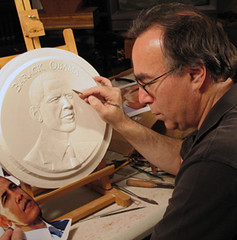
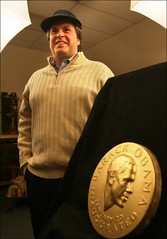
Joe Levine adds:
QUERY: IMAGE OF ARMAND-DELILLE RABBIT MEDAL SOUGHT
Ed Snible writes:I was wondering if anyone has a picture of the medal - I couldn't locate one. Thanks.
To read the Wikipedia entry, see: Paul Felix Armand-Delille (en.wikipedia.org/wiki/Paul_Armand_Delille)
QUERY: NUMISMATIC AND EXONUMIC INAUGURAL SOUVENIRS SOUGHT FOR WHITMAN VAULT BOOK PROJECT
Dennis Tucker of Whitman Publishing writes:Examples might include medals, tokens, scrip, or even commemorative Metro passes, phone cards, or similar --- I'll let the reader define "numismatic" and "exonumia"! Souvenirs from the days leading up to the inauguration (e.g., from the Inaugural Train trip) or following (e.g., from the inaugural balls and celebrations) are also welcome.
Here's the description of Whitman's first Vault book. -Editor
HAS EARLY ARTWORK FOR THE MORGAN DOLLAR BEEN FOUND?
Web site visitor Steve Matzke writes:It is original and has the sculptors’ original measurement markings. It appears to be an galvano. Is there are market for items like these? Any assistance is greatly appreciated!
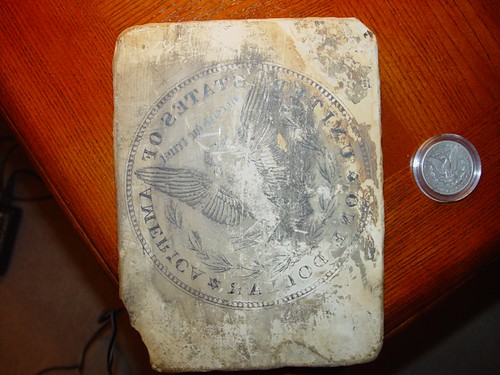
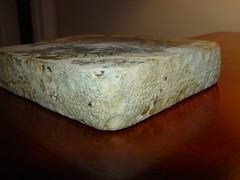
Steve forwarded the following scan which shows more detail. Click here to view a larger version on Flickr: http://www.flickr.com/photos/coinbooks/3224454992/sizes/o/ . -Editor
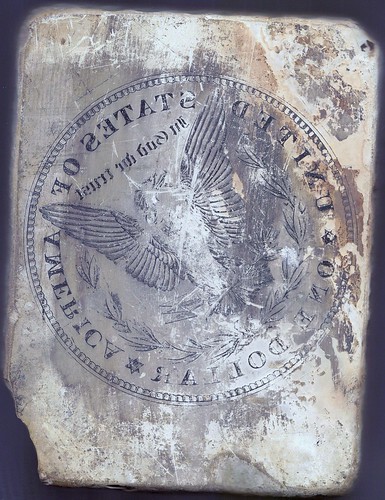 Steve writes:
Steve writes: When you look closely at the talon, head and wing areas of the eagle, you can see the great attention someone took to detail to even the smallest points of the engraving and to the design. I would think that this was not done by someone just wanting to use it as a picture of sorts, but someone who was trying to show what the conceptual design would look like down to the finest detail.
The engravers layout marks in the corners for size. The design is exactly 6 inches in diameter measured from the outer most ink circle. An actual Morgan dollar is 1.5 inches across so this would make the design exactly a 4:1 ratio of the coin.
The entire piece measures approximately 6 and 3/8 inches wide by approx. over 8 1/2 inches tall. It is over 2 inches thick and weighs approximately 3-5 lbs (or more as it has never been weighed yet)
The indentation mark at the south right corner is a thumbprint in the medium. There are finger impressions (not shown) all along the top edge of the piece. It is if someone pressed (or poured?) in into a mold then pulled it out of the mold then applying the ink medium over the engraving.
Steve also forwarded images to other numismatists, including Julian Leidman. Julian writes:
So - are any of our readers familiar with the tools and processes used by coin designers in the 1870s? Is such a design on stone a typical part of the process? For more information about this piece, Steve can be contacted at stevematzke@gmail.com . -Editor
MORE ON DANIEL CARR'S HARD TIMES TOKENS
Daniel Carr writes:I just wanted to point out that it also has edge lettering which can be hard to see. At the top on the edge it says "Don't Borrow Money". At the bottom on the edge it says "Don't Pay Interest".
MORE ON "ABRAHAM LINCOLN TURNS 200"
 Last week I mentioned the Lincoln article in the Reader's Digest. I just learned you can read this article on the web, complete with the 5-question quiz (but without the illustration of Abe and the two Lincoln cents balancing on a tight rope -- for that you will have to buy the magazine). Read it free at: Abraham Lincoln Turns 200 (www.rd.com/your-america-inspiring-people-and-stories/
Last week I mentioned the Lincoln article in the Reader's Digest. I just learned you can read this article on the web, complete with the 5-question quiz (but without the illustration of Abe and the two Lincoln cents balancing on a tight rope -- for that you will have to buy the magazine). Read it free at: Abraham Lincoln Turns 200 (www.rd.com/your-america-inspiring-people-and-stories/honest-abraham-lincoln-turns-200/article114713.html)
ON THE SOCIETY OF BEARDED NUMISMATISTS
Regarding last week's mention of the S.O.B. Numismatists medal, Nancy Green writes:In general they were deserving individuals and I remember thinking I would love to have one of the medals, even at the cost of being selected to be "SOB of the Year". (Of course I was never close to being in the running.) The parties were generally in good fun and with a surfeit of liquid libation.
Denis Loring writes:
Tom DeLorey writes:
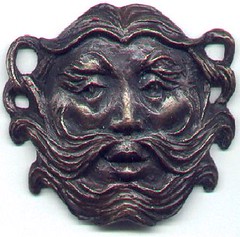
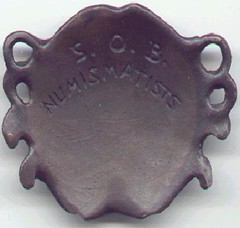
Royal Canadian Numismatic Association life member Richard Becker writes:
Jack, I and our wives had been friends for some years since I had served under him as a CNA executive representing the Eastern USA. Although the SOB's were originally to be all bearded, I came on board just because Jack and my wife both agreed that I was a true S O B, and thus eligible. Although clean shaved, I became a member when, unknown to me, my wife gave Jack a generous donation (called bribery) and had me initiated as a full time, medal wearing member at an annual CNA convention. Those were fun years. I still proudly wear my medal whenever I am fortunate enough to be able to attend the annual RCNA conventions.
Joe Boling writes:
I joined (beardless, per Army policy) about 1980 or 81. Each member took a title- Mine was Shogun. I remember Denis Loring was Stochastic Actuary and Ingrid Smith was Beard Inspector. Veffer and Criswell were each Half-President for Life (and may have had other titles as well).
The society's uniform was a yellow t-shirt decorated with one's title. The de Pedery-Hunt badge was not obtained by joining. One badge was given each year to whomever the current holders thought deserved to receive it. I believe I received the last one awarded, at Atlanta in 1987. Most are bronze, as illustrated in The E-Sylum. At least three were silver - Grover's, Jacks' and Yasha Beresiner's. The society faded away about the time the last badge was presented.
ON MEDALS AND THE ORIGINS OF TRADEMARKS
François Velde of the Federal Reserve Bank of Chicago writes:Mint marks for individual mint-masters, which appear roughly at the same time, are similar. Arguably their purpose was different. But the concept of trademark was more general, including its legal aspect.
The great jurist Bartolo, in his tract "de insignis et armis" (unfinished at his death in 1357), gives several examples of trademarks, such as the watermarks of paper-makers or marks of sword-makers, and explains why they ought to be considered as protected by law against counterfeiting, even discussing who owns the trademark when a partnership is dissolved. Going farther back, one finds trademarks imprinted on Roman bricks and amphorae by their producers.
Bob Leonard adds:
THE BOOK BAZARRE
ON THE ANA'S LAMP OF KNOWLEDGE LOGO
Joe Boling writes:The American Numismatic Association Board of Governors has voted unanimously to acknowledge that the "Lamp of Knowledge" is and remains the official seal of the Association.
The vote, taken during a conference call on June 2, authorizes the use of the Lamp of Knowledge on certificates, awards, the ANA Federal Charter, Bylaws and Code of Ethics documents. The ANA will continue its use of the current ANA logo for marketing purposes until a new logo is selected by the membership and confirmed by the Board.
The current logo, created around the Peace Dollar, has been in use since 2003. ANA President Barry Stuppler, who has championed the creation of a new logo, announced plans last winter to ask five accomplished medallic artists to develop designs for a new logo. Those designs, which were submitted in April, were to be displayed on the ANA website and published in The Numismatist. Members would then vote on their favorite designs.
"We received some beautiful artwork," Stuppler said. "However, the designs we received would be difficult to use in a variety of ways as required for a logo. As a result, we have decided to seek additional input from artists from a variety of disciplines."
Stuppler said that once artists have been identified and additional submissions received, the membership would be asked to provide input.
"We want to be sure that we make the right decision in selecting a logo for this Association and that the voices of our membership are heard," Stuppler said.
Stuppler emphasized that no operating funds will be utilized to develop or implement a new logo. "We will need to raise about $62,000, and no new logo will be implemented until those funds are in hand." He added that the fundraising effort has been seeded with a $2,000 anonymous donation.
Stuppler said the decision to use the Lamp of Knowledge as the official seal recognizes the desire of many members to utilize the time-honored symbol. "It's an important icon to so many of our members," he said. "I think that placing the old logo on official medals, awards and documents is a vital step in responding to the wishes of the membership."
MIKE ELLIS ANNOUNCES RUN FOR ANA BOARD
We need a Board that keeps the membership and numismatic community in the highest regard. Board members must be willing to work hard to get finances further under control. They must also keep the line of communication open with the membership while keeping the membership happy and excited about belonging to the ANA. In doing my part I am pleased to announce I am running for a position on the ANA Board of Governors.
Having become a collector in 1968, I come with over 20 years experience as a professional numismatist and numismatic educator in addition to 20 more years as a collector. I served 12 years as a board member and officer of CONECA; a total of six terms with the last eight years and 4 terms as President of the organization. I have been an instructor for ANA Summer Seminars since 1996 (teaching Beginning Grading during week two this year), have given several Numismatic Theater presentations at ANA Anniversary Conventions including one for the NBS in Orlando and have made many educational appearances at other shows and club meetings across the country. I have shared vital ANA information with E-sylum readers several times in the past, some of it revelations first published here that became huge news in the numismatic community.
Of special interest to the NBS members and E-Sylum readers, you will be happy to note that I am a very strong advocate of numismatic publications and have caused many numismatic references to get published and continue to do so today. I consider the program to afford would-be authors to get published while at CONECA to be one of my greatest numismatic accomplishments. Without it many excellent attribution guides would not have been published.
I have contributed in various ways to dozens of numismatic references; served as editor of Errorscope, the award winning, official publication of CONECA, Cherrypickers’ News, and The Cherrypickers’ Guide to Rare Die Varieties: 4th Edition, Volume I for which I received an NLG award. I have also authored numerous articles in various numismatic publications and have been a columnist for several, including Numismatic News Errorscope and Cherrypickers’ News. I am a huge supporter of “getting it published for public consumption” and “sharing the knowledge.”
I first became a consultant to ICG in 1998 serving in that capacity until April of 2006 when I became a full time grader with ANACS moving to ICG in January of 2008 when ANACS was sold and am currently the Senior Grader and Variety Specialist for Dominion Grading Service (DGS) of Virginia Beach, Virginia where I continue to write numismatic articles.
For my efforts on behalf of collectors and dealers I have been awarded the ANA’s “Glenn Smedly Award” and CONECA’s highest honor, the “Dr. Lyndon King Award.”
If there are any questions I can answer, any actions I can take, or you want to assist in a greater way, do not hesitate to email me at mikeellis2001@yahoo.com or call me at 512-944-4784. I very much appreciate your support, and together we can help further the mending and improving of the ANA.
MORE ON THE FIRST APPEARANCES OF THE SESTERTIUS AS A COIN
Last week, Douglas Mudd, Curator of the ANA's Edward C. Rochette Money Museum wrote:The brass sestertius that Jared refers to and that most of us are familiar with was not introduced until the time of Augustus (around 18 BC). So for the time period which the First Man in Rome discusses, McCullough is perfectly correct – in fact I am very surprised and impressed that she caught a numismatic detail that most numismatists, even those who collect Roman coins, would miss. Yet another reason why the First Man in Rome series is one of my favorite historical novels!"
Rick Witschonke writes:
Bob Leonard adds:
ON EVALUATING THE VALUE OF MONEY OVER TIME
Such statements are meaningless without context. These 824 staters weighed 5 grams each, totaling 4120 grams or 132.5 ounces or about $125,000 at today's volatile range for gold. If gold has constant value over time, then that figure has some validity. However, no amount of Iron Age gold would have bought an Iron Age iPod, so we need another view.
We know that the Roman aureus of about this same time weighed 8 grams and was worth 25 denarii. So, these Britannic "staters" were worth about 15 1/2 denarii each. We know from ancient documents such as Biblical citations from the New Testament that a worker in the fields earned a denarius a day. As the average factory wage in America today is about $100 per day, this translates to $1,287,500.
However, we know from other records that a secretary earned 15 denarii per month and a legionary private 20. (See http://www.ancientcoins.biz/pages/economy based on their bibliography citing Duncan-Jones The Economy of the Roman Empire and Harl Coinage in the Roman Empire). So each stater would have bought 3 weeks for a soldier or 1 month for a secretary.
Assuming that a modern clerical worker earns more than an average laborer at $40,000 per year, the 824 coins represent about $2,750,000. However, unlike the Roman trooper who earned more, our US Army privates only start at less than half the pay of a secretary, at $16,000 per year. Again, however, the modern army is a different contract than the ancient.
Finally, most of this is moot because the folk of ancient Britain were not a wage economy. These coins were then what they are now: a treasure hoard; static wealth; not earned (or earnable) income; certainly not an investment with a discountable risk. As such, oddly enough, they actually had zero value back then.
WILL EUROPEAN NATIONS CONSIDER DROPPING CENT COINS?
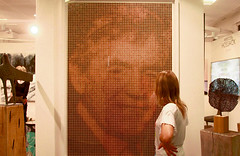 A recent article in the Irish Times repeats a story originally published in the New York Times of one of Ireland's wealthiest landowners, Sean Dunne, stooping over to pick a penny off the floor in a pub.
A recent article in the Irish Times repeats a story originally published in the New York Times of one of Ireland's wealthiest landowners, Sean Dunne, stooping over to pick a penny off the floor in a pub. “I am never, never too proud to pick a penny up from the floor,” Dunne is quoted as saying. “I know the value of money.”
But, really, what is the value of a penny? Andrew Parsons writes "An Irishman's Diary" for Reuters. In his recent column he comments on Europeans' low esteem of the penny:
"This view is shared by many around the world, and efforts to remove small-value coins from circulation are gathering momentum. Pennies are expensive and inconvenient, say their opponents, and aren’t worth the metal they are minted with."
He relates how Australia and New Zealand have dropped all coins less than 5 cents and that Finland opted out of having one and two-cent coins minted when they switched to the euro in 2002. [Two weeks ago I reported in The E-Sylum where Italian merchants are refusing to accept low value coins.]
"Anti-penny sentiment," states Parsons, "is on the rise among Europeans. A recent Eurobarometer poll showed a majority in favor of ditching 1 and 2 cent coins completely. Abolitionism was strongest in Belgium, where efforts have begun to have the coins withdrawn."
He gives further evidence for a nickel coin. (And relates how Joseph Wharton, who owned America's only nickel mine, talked U.S. Congress into converting to a nickel 5-cent coin in 1865. Wharton became wealthy and founded the Wharton School of Business.)
"Consider the benefits of abolition. The Government would save the cost of manufacturing and distribution. Since so many of them end up in vacuum cleaners or down the side of sofas and have to be replaced, 1, 2 and 5 cents account for 80 percent of the euro coins produced." This article is well worth reading: An Irishman's Diary (www.irishtimes.com/newspaper/opinion/2009/0115/1231738223519.html)
WHO'S HELPING ZIMBABWE PRINT ITS HYPERINFLATIONARY BANKNOTES?
The latter question has a simple answer. If you are printing notes in the trillions, just slip one from the top of the stack and satisfy your debt. OK, even with the high inflation, Zimbabwe must have some assets abroad that only they know about. It could be gold stored in the Federal Reserve vault in New York, gold stored with an American smelter (Englehardt comes to mind), or with some foreign country such as Russia or Iran.
Who is the printer? If I, or one of our savants of banknotes, could get hold of a note we could determine whether they are printed locally or by a security printer. If a security printer, then it will be more difficult to determine the source unless one is especially conversant with the style of noted engravers or the engraving style of government or private security printers.
Collectors (researchers and authors) such as Gene Hessler might be able to discern the engraving style.
However, with the correct incentive, there are many security printers that could print currency undetected and whose financial records are not open to scrutiny. Again, Iran comes to mind.
Granvyl Hulse adds:
MONEY AND HOW IT GOT THAT WAY: A LOOK AT MONEY AND ART
 In 1936, Henry Miller published a pamphlet called "Money and How It Gets That Way." It is not one of the works for which he is best remembered, partly because it's written in an academic style that can only be dubbed "counterfeit Henry." But Miller did succeed in his goal, which was not to settle the problem of money but to "unsettle" it. At the time of the pamphlet's publication, the world was mired in the Great Depression.
In 1936, Henry Miller published a pamphlet called "Money and How It Gets That Way." It is not one of the works for which he is best remembered, partly because it's written in an academic style that can only be dubbed "counterfeit Henry." But Miller did succeed in his goal, which was not to settle the problem of money but to "unsettle" it. At the time of the pamphlet's publication, the world was mired in the Great Depression.Boggs' conceptual exercise might seem a bit esoteric to some, but the point he was making was the same one Miller made in his pamphlet: to unsettle people about their relationship to money. In short, the real world went through exactly the sort of existential dilemma that Boggs was positing in the fantasy world of his artistry. His ultimate goal was to force "collectors" to ask themselves: Is art worth bunches of little green pieces of paper, or does art have a value beyond that?
For the people who could afford Boggs' own artwork, the answer was clear: It's an investment and a status symbol. So, what is money? Or for that matter, what is art?
Closer to home we have Michael Theise, a prodigiously talented artist in Wallingford, who paints — among other things — currency, stock certificates, Wall Street Journals, and Monopoly boards. The graduate of Paier College of Art in Hamden has, at age 50, become one of America's foremost tromp l'oeil painters — his renderings of reality so precise and tantalizing they are said to "fool the eye." You really feel as if you can peel the dollar bills off of his canvases.
"Often after a showing of my work, I find little scratches on the surface of the painting where people have actually tried to peel the bills off," says Theise, whose work was until recently on display at the New Britain Museum of American Art's New/Now gallery, and is sold at the Cooley Gallery in Old Lyme and the Vose Gallery in Boston.
"I started doing the currency to make people stop in their tracks and look at the paintings. They were breezing past my other tromp l'oeil paintings, thinking they were collages, and only stopping at the pictures of money. Money is instantly recognizable and any viewer can tell if the likeness is right or wrong."
Rather than, like Boggs, making some esoteric statement about the value of art and money, Theise simply finds currency aesthetically pleasing. To him, in its way, a 5-dollar bill or a 10-pound note is a small work of art.
"Not only are the bills works of art, they are also a history lesson," says Theise. "You learn what cultures value by what they put on their bills."
Theise is also well aware of the trompe l'oeil tradition in America, dating back to 19th-century masters like William Harnett and John Haberle and including 20th-century painters like Boggs and Otis Kaye; the latter Theise considers one of the most underappreciated artists of his time.
"There's definitely an established history of painting money in America. Some artists got in trouble, some flaunted it. I'm not trying to fool anyone. I want people to realize that these are paintings of money."
To read the complete article, see: The Root of All Evil: Money and how it got that way (http://www.hartfordadvocate.com/article.cfm?aid=11397)
ROYAL MINT MISTAKE: 2008 OLD STYLE OBVERSE MULED WITH NEW STYLE REVERSE
Philip Mernick writes:However, there is still the possibly of dated mules appearing as all "old style" coins had a beaded obverse and the new coins have an unbeaded obverse. It seems probable that all denominations have been struck in both old and new styles so it gives collectors a lot more to look out for.
STOLEN SILVER PENNY OF EDWARD THE CONFESSOR RETURNED TO ABBEY
 The Malmesbury Abbey in England has an 1042 Edward The Confessor silver penny back in its possession. It was stolen last June but police learned of the man who stole it from an anonymous tip from someone who heard the thief bragging he took it. At the Abbey they learned the thief leaned on the case where it had been displayed creating a half-inch opening, enough to withdraw the coin.
The Malmesbury Abbey in England has an 1042 Edward The Confessor silver penny back in its possession. It was stolen last June but police learned of the man who stole it from an anonymous tip from someone who heard the thief bragging he took it. At the Abbey they learned the thief leaned on the case where it had been displayed creating a half-inch opening, enough to withdraw the coin. 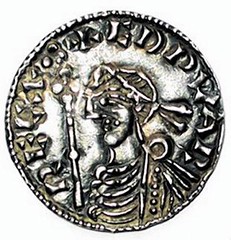
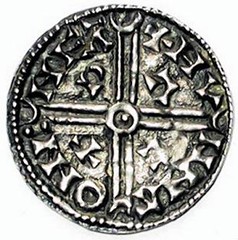
_1_000_year_old_coin_returned_to_Malmesbury_Abbey/)
FEATURED WEB PAGE: MEDALLIC HISTORY OF INTOLERANCE
This week's Featured Web Page is an article by Ben Weiss on the Medallic History of Religious and Racial Intolerance.The subtle ones sometimes are more effective, and therefore more dangerous, as the observer is not as likely to be aware of how he/she is being manipulated to support the views of the artist. Another category of medals shown here do not promote religious bigotry directly, if at all, but rather are included in this article to illustrate and amplify further the history of the period discussed, particularly as it involves conflicts and wars based on religious differences between the parties involved.
ANTI-SEMITIC MEDALS: While prejudice among the various religious groups exists among them all to varying degrees, over the ages bigoted acts against the Jews have been among the most prevalent, severe, and unrelenting. History has shown that Jews, while welcomed in times of need, often were maligned, periodically expelled from their native lands, and sometimes even subjected to mass murder. Some of this bigotry is reflected in the issuance of medals purposefully designed to vilify the Jewish community.
Anti-Semitic medals are probably the most common and most notorious medals for spreading religious hatred, a topic that has been considered in some detail by Daniel Friedenberg in his book Jewish Medals: From the Renaissance to the Fall of Napoleon (1503-1815).
www.kunstpedia.com/articles/373/1/Medallic-History
-of-Religious-and-Racial-Intolerance--Medals-as-instruments-for-promoting-bigotry/
